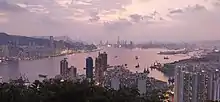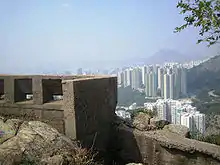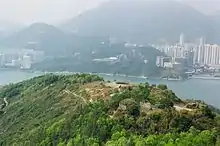Devil's Peak, Hong Kong
Devil's Peak (Chinese: 魔鬼山 | 炮台山) is a peak that lies beside Lei Yue Mun channel close to Yau Tong, Hong Kong. The area around the peak was garrisoned by the British Army in the 20th century and prior to that, by local pirates in the 19th century to control the passage of Lei Yue Mun, an important nautical passage that leads to Victoria Harbour. The remnants of a redoubt and batteries are still visible on the peak.[1]
| Devil's Peak | |
|---|---|
| 魔鬼山 | |
 Devil's Peak viewed from Mount Parker | |
| Highest point | |
| Elevation | 222 m (728 ft) |
| Naming | |
| Native name | 魔鬼山 | 炮台山 (Chinese) |
| Geography | |
 Devil's Peak Location of Devil's Peak in Hong Kong | |
| Location | |




Geography
Devil's Peak stands at 222 metres in height. To the east of the peak lies Junk Bay Chinese Permanent Cemetery and Yau Tong lies to its west. The hill extends its ridge south to water in Lei Yue Mun and north to another peak called Chiu Keng Wan Shan.
Military history
The major parts of the military sites on Devil's Peak were built between 1900 and 1914. The four main clusters of military structures that remain are:
- Devil's Peak Redoubt, which stands on the summit at a level of 222m. It was built in 1914.[2]
- A small site at 196m
- Gough Battery[3] - upper battery at 160m, was built in 1898 with 2 6-inch guns; one later replaced by 9.2-inch guns; guns removed in 1936 to Stanley Fort; likely named for former Commander-in-Chief of British Forces in China Hugh Gough, 1st Viscount Gough
- Pottinger Battery - lower battery at 81m, with 9.2-inch guns; guns removed in 1936 to Bokhara Battery, Cape D'Aguilar; named for Governor Sir Henry Pottinger
A list of troops whom were stationed here (mainly during World War II):
- 5/7 Rajput Regiment
- 1st Mountain Battery of the Hong Kong Singapore Battalion of the Royal Artillery
Access
Section 3 of The Wilson Trail runs through the foot of Devil's Peak. It is possible to access the fort on foot from the Wilson Trail from either Yau Tong or from Lam Tin.
See also
References
- "Discover relics of war in Hong Kong". South China Morning Post. 19 February 2014. Retrieved 3 October 2019.
- Luu, Chieu (11 January 2017). "The ultimate guide to Kowloon, Hong Kong's 'dark' side". CNN Travel. Retrieved 3 October 2019.
- "Welcome to Film Services Office – Location Library". www.fso-createhk.gov.hk. Retrieved 3 October 2019.
External links
| Wikimedia Commons has media related to Devil's Peak, Hong Kong. |
- Batteries on Devil's Peak
- Lai, Lawrence; Ho, Daniel; Leung, Hing Fung (2002). "Survey of the Devil's Peak redoubt and Gough Battery" (PDF). Journal of the Royal Asiatic Society Hong Kong Branch. Hong Kong. 42: 101–137. ISSN 1991-7295.
- Lai, Lawrence W. C.; Ho, Daniel C.; Yung, P. (2007). "Survey of the Pottinger Battery" (PDF). Journal of the Royal Asiatic Society Hong Kong Branch. Hong Kong. 47: 91–114. ISSN 1991-7295.
- Facilities Management and Planning for Heritage Sites: Lessons Learnt From a Pilot Study on Disused Military Sites
- Fun in Kwun Tong - Devil's Peak Batteries